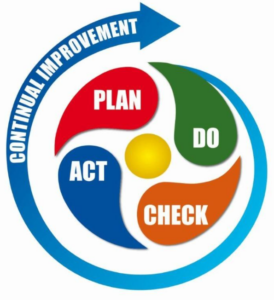Continual Improvement: A Key to Business Growth!
Do you want your business to move in a positive direction? Want it to be more competitive? Embrace continual improvement! But, what is it precisely?
It is an ongoing improvement of services, products or processes through innovative and incremental improvements.
How is it done?
The plan-do-check-act (PDCA) Quality Modal
Among the most commonly used tools for it is “the plan-do-check-act (PDCA) cycle” – a four-step quality model, also referred to as Shewhart Cycle or Deming Cycle:
- Plan: Recognise an opportunity or a break, then plan and prepare for change.
- Do: Execute the change on a small scale.
- Check: Analyse the results of the change using the data and conclude if it made a difference or not.
- Act: Execute the change on a wider scale, if it was successful and constantly evaluate your results. Contrariwise, if the change did not work, restart the cycle.

Apart from PDCA, there are other widely used methods of continuous improvement as well — such as Lean, Six Sigma as well as Total Quality Management — which focus on teamwork and employee involvement; assessing as well as schematising processes; and reducing defects, variation and cycle times.
In recent years, many businesses and companies have started to make great use of the ingenious potential of their employees’ minds. The continual improvement process is closely related to idea management. In contrast to the method of innovation management and the concept of innovation, where growth is frequently attained through technological leaps, the process of continuous improvement is a far more slow and steady method.
Many companies and businesses establish CIP in order to prove processes and structures for quality optimisation are within the range of an IS0 9001 certification. But Continual Improvement Process is much more: it is a basic attitude to attain improvements of products, services or processes, as well as gains in quality and competence through systematic idea development and continuous brainstorming.
These improvements are typically developed by CIP teams, quality circles as well as idea workshops. Due to the prospects of digitalisation, modern tools like CI-software are being used more progressively.
What Drives Continual Improvement (CI)?
CI is driven by the objectives and goals set by the organization’s management team. Quality objectives should at least address the following:
- Individual customer needs and requirements
- The improvement of internal efficiency
- The level of performance expected by your market sector
There is no requirement, however, that the business or organisation should set objectives for improvement for all the processes simultaneously. It would be impractical to expect a business or an organisation to grow in all potential improvements at the same time.
Commitment of resources – prioritised by top management – will be required for each improvement, especially if investment is required.
How to Recognise Sources of Improvement Opportunities?
Improvement opportunities input are acquired from the below-mentioned sources:
- Customer feedback and complaints
- Customer satisfaction
- Market research and analysis
- Inputs from suppliers, employees as well as other interested parties
- Process non-conformances or records of product
- External and internal audits of the quality system
- Data from product and process characteristics and their trends
Improvement opportunities may also be recognised on a special project basis, such as:
- Excessive testing/inspection
- Non value-added use of floor space
- Excessive costs to quality as well as failures
- Excessive storage and handling
- Machine set-up changeover times
To Wrap Up
Continual improvement process’ effectiveness is often determined by searching for evidence that the business or organisation has ensured that ‘objectives set for improvement are consistent with the general aim of improving customer satisfaction and enhancing the level of Quality Management System performance’.
Not matter how you do it, improvement is the actual point of executing the ISO 9001 Quality Management System, and one basic key to improvement is to set targets or objectives for your processes, then compare actual results to the set objectives on a regular basis, and then do corrections, when necessary.

 Phil Lane
Phil Lane 100% success – Certification is guaranteed!
100% success – Certification is guaranteed!


